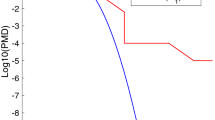Abstract
Ephemeris faults must be monitored when integrity is provided for safety–critical applications. The ground facility consisting of multiple short-baseline reference receivers is used to detect the ephemeris faults. The test statistic for the ephemeris fault monitoring is constructed by the double-differenced carrier phase observation. The false alarm and missed detection errors of the proposed ephemeris fault monitoring method are constrained by accounting for the effect of ephemeris fault and geometry-free ambiguity resolution failure simultaneously. Real BDS data with simulated ephemeris fault are utilized to test the proposed method. The experimental results have shown that the ephemeris fault can be detected by satisfying the required false alarm and missed detection probabilities. The detection power loss of the proposed method can be constrained at less than 0.1%. It has been proven that the real-time protection of the proposed method is achievable against Type A and Type B ephemeris faults.








Similar content being viewed by others
References
China Satellite Navigation Office (2013) BeiDou Navigation Satellite System Open Service Performance Standard. Version 1.0
Gao GX, Tang H, Blanch J, Lee J, Walter T, Enge P (2009) Methodology and case studies of signal-in-space error calculation top-down meets bottom-up. In: Proceedings of the ION GNSS 2009, Institute of Navigation, Savannah, Georgia, USA, September 22–25, pp 2824–2831
Gunning K, Walter T, Enge P (2017) Characterization of GLONASS broadcast clock and ephemeris: nominal performance and fault trends for ARAIM. In: Proceedings of the ION ITM 2017, Institute of Navigation, Monterey, California, USA, January 30, vol 2, pp 170–183
Heng L, Gao GX, Walter T, Enge P (2012) GPS signal-in-space integrity performance evolution in the last decade. IEEE Trans Aerosp Electron Syst 48(4):2932–2946
IS-GPS-200J (2018) NAVSTAR GPS space segment/navigation user segments interface. GPS Wing
Jia C, Zhao L, Li L, Li H, Cheng J, Li Z (2017) Improving the triple-carrier ambiguity resolution with a new ionosphere-free and variance-restricted method. Remote Sens 9(11):1108–1124
Khanafseh S, Pullen S, Warburton J (2012) Carrier phase ionospheric gradient ground monitor for GBAS with experimental validation. Navigation 59(1):51–60
Khanafseh S, Patel J, Pervan B (2017) Ephemeris monitor for GBAS using multiple baseline antennas with experimental validation. In: Proceedings of the ION GNSS+ 2017, Institute of Navigation, Portland, Oregon, USA, September 25–29, pp 4197–4209
Khodabandeh A, Teunissen P (2016) Single-epoch GNSS array integrity: an analytical study. In: Sneeuw N, Novák P, Crespi M, Sansò F (eds) International Association of Geodesy symposia, vol 142, pp 263–271
Kovach K, Berg J, Lin V (2008) Investigation of upload anomalies affecting IIR satellites in October 2007. In: Proceedings of the ION GNSS 2008, Institute of Navigation, Savannah, GA, USA, September 16–19, pp 1679–1687
Li L, Quddus M, Ison S, Zhao L (2012) Multiple reference consistency check for LAAS: a novel position domain approach. GPS Solut 16(2):209–220
Li L, Jia C, Zhao L, Yang F, Li Z (2017) Integrity monitoring-based ambiguity validation for triple-carrier ambiguity resolution. GPS Solut 21(2):797–810
Li L, Shi H, Jia C, Cheng J, Li H, Zhao L (2018) Position-domain integrity risk-based ambiguity validation for the integer bootstrap estimator. GPS Solut 22:39
Montenbruck O, Steigenberger P, Hauschild A (2015) Broadcast versus precise ephemerides: a multi-GNSS perspective. GPS Solut 19(2):321–333
Murphy T, Harris M (2008) RAIM Performance in the Post SA Era. In: Proceedings of the ION GNSS 2008, Institute of Navigation, Savannah, GA, USA, September 16–19, pp 139–150
Patel J, Khanafseh S, Pervan B (2018) Spatial gradient monitor for GBAS. In: Proceedings of the IEEE/ION PLANS 2018, Monterey, CA, USA, April 23–26, pp 571–582
Pervan B, Chan F (2003) Detecting global positioning satellite orbit errors using short-baseline carrier phase measurements. J Guid Control Dyn 26(1):122–131
Pervan B, Gratton L (2005) Orbit ephemeris monitors for local area differential GPS. IEEE Trans Aerosp Electron Syst 41(2):449–460
Pullen S, Park Y, Enge P (2009) Impact and mitigation of ionospheric anomalies on ground-based augmentation of GNSS. Radio Sci 44(RS0A21):1–10
Spirent Report (2017) A lesson from the Galileo clock failures: GNSS systems need more rigorous testing
Tang H, Pullen S, Enge P, Gratton L, Pervan B, Brenner M, Scheitlin J, Kline P (2010) Ephemeris Type A fault analysis and mitigation for LAAS. In: Proceedings of the IEEE/ION PLANS 2010, Institute of Navigation, Indian Wells, CA, USA, May 4–6, pp 654–666
Teunissen PJG (1995) The least-squares ambiguity decorrelation adjustment: a method for fast GPS integer ambiguity estimation. J Geod 70(1–2):65–82
Teunissen PJG (1998) Success probability of integer GPS ambiguity rounding and bootstrapping. J Geod 72(10):606–612
Teunissen PJG (2001) Integer estimation in the presence of biases. J Geod 75(7–8):399–407
Verhagen S, Li B, Teunissen PJG (2013) Ps-LAMBDA: ambiguity success rate evaluation software for interferometric applications. Comput Geosci 54:361–376
Walter T, Enge P (1995) Weighted RAIM for precision approach. In: Proceedings of the ION GPS 1995, Palm Springs, CA, USA, September 12–15, pp 1995–2004
Acknowledgements
The authors appreciate the Hong Kong Geodetic Survey Services for providing static BDS data. This research was jointly funded by the National Natural Science Foundation of China (Nos. 61773132, 61633008, 61803115), the National Key Research and Development Program (No. 2017YFE0131400), the 7th Generation Ultra Deep Water Drilling Unit Innovation Project sponsored by Chinese Ministry of Industry and Information Technology, the Heilongjiang Province research Science Fund for Distinguished Young Scholars (No. JC2018019), and the Fundamental Research Funds for Central Universities (Nos. HEUCFP201768, 3072019CF0401).
Author information
Authors and Affiliations
Corresponding author
Additional information
Publisher's Note
Springer Nature remains neutral with regard to jurisdictional claims in published maps and institutional affiliations.
Rights and permissions
About this article
Cite this article
Li, L., Liu, X., Jia, C. et al. Integrity monitoring of carrier phase-based ephemeris fault detection. GPS Solut 24, 43 (2020). https://doi.org/10.1007/s10291-020-0958-4
Received:
Accepted:
Published:
DOI: https://doi.org/10.1007/s10291-020-0958-4




